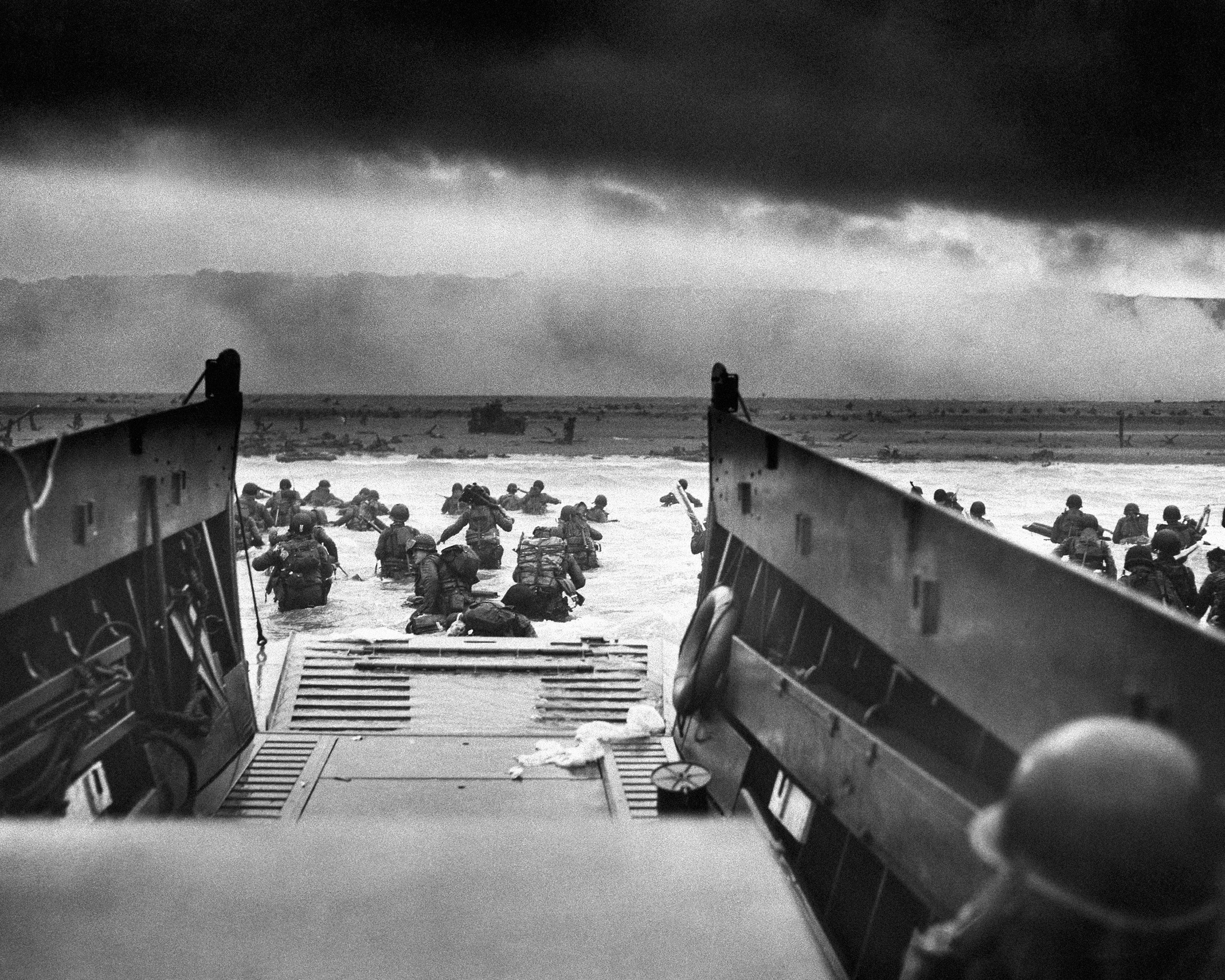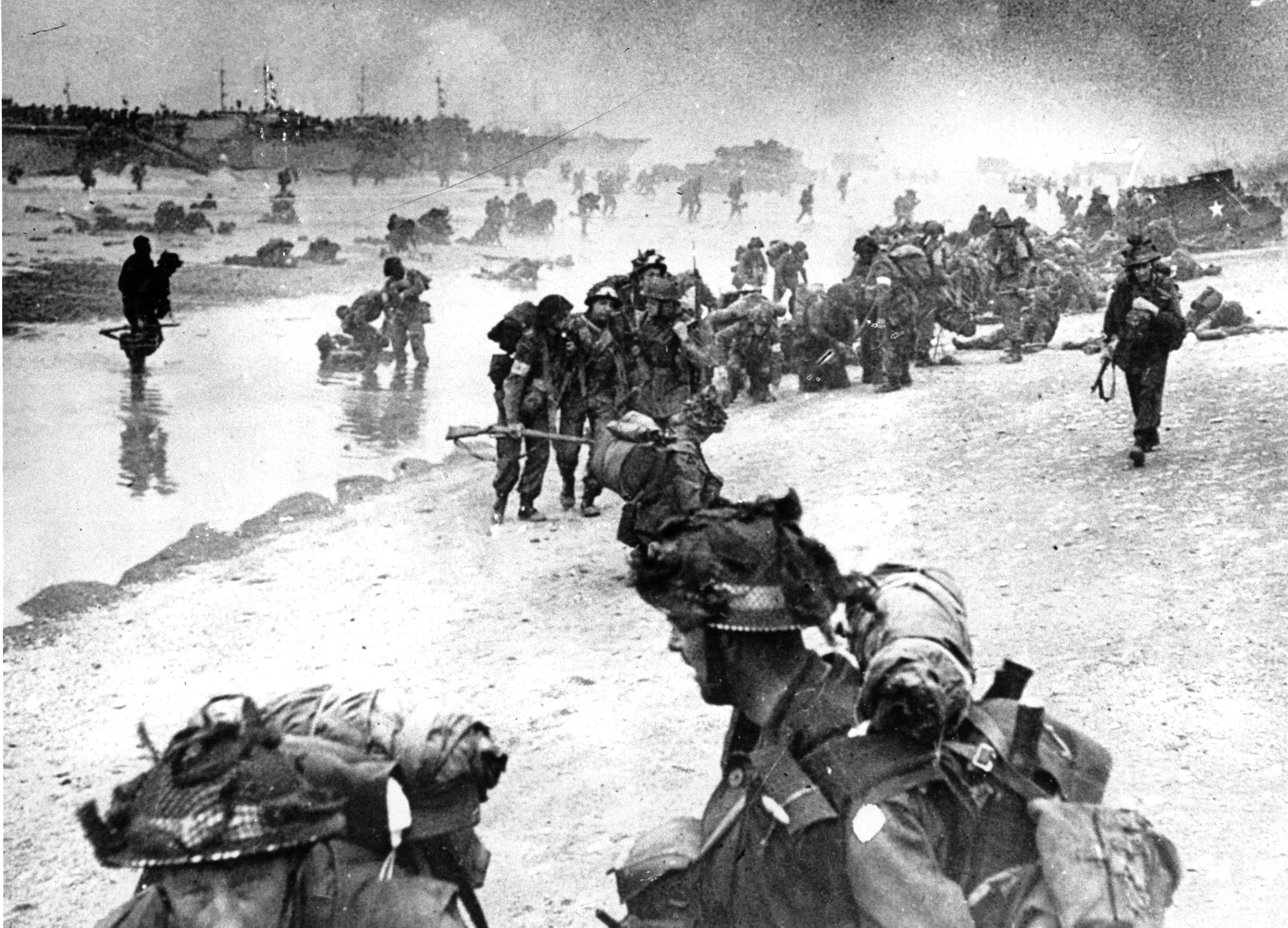80 Years Since D-Day and the Battle of Normandy

FLASH
June 6, 1944
London— Eisenhowers Headquzarters Announce Allies Land in France.
The anxiously awaited FLASH came off the printer in the London bureau of the Associated Press at 9:33 a.m. local time, the exact time set for its release by SHAEF (Supreme Headquarters Allied Expeditionary Force) in Portsmouth, England and three hours after the first sea landings. From London, it ricocheted around the world, for the Allied invasion of Europe during World War II was the “number 1 Story of Our Times,” according to the AP’s internal magazine, The AP Inter-Office.
Editorial planning had gone on for months in New York and London. Everyone knew that the timing of D-Day, the largest amphibious landing in military history, would come down to a narrow window of relatively favorable weather conditions on the English Channel. But like the weather, fate would be indifferent to those who led the invasion from the sea or from the air. Of the nearly 160,000 Allied troops that assailed Normandy on June 6, 1944, 4,414 died that day. 73,000 Allied forces were killed in the ensuing battles across France.
(EDS NOTE - Typo on “Eisenhower’s Headquarters” is in the original)
Artist and illustrator Howell Dodd depicts AP reporting and photographic assignments for the D-Day invasion of June 6, 1944. AP Inter-Office, June/July 1944. (AP Photo/AP Corporate Archives)
D-Day signaled the opening of the Battle of Normandy, code-named Operation Overlord. In that battle, 20,000 French civilians died. Norman towns of great age and beauty were laid waste. Because we know how the story ends, we forget the price paid by the residents of Saint Lô, Pont-l’Évêque, Valognes, Caen, Cherbourg, Falaise and so many other villages and farms of Lower Normandy, partially or totally destroyed by Allied bombs meant for the German army. It would take two decades to reconstruct them.
Paris was liberated on Aug. 25, 1944, and Germany surrendered unconditionally on May 7, 1945. Finally, Japan surrendered aboard the U.S.S. Missouri in Tokyo Bay on Sep. 2, 1945, six years and a day after the war began.
Supreme Allied Commander Gen. Dwight D. Eisenhower visits paratroopers of the 101st Airborne Division at the Royal Air Force base in Greenham Common, England, three hours before the men board their planes as part of the first assault wave of the invasion of the continent of Europe, code-named Operation Overlord, June 5, 1944. (AP Photo/U.S. Signal Corps)
United States military loading transports for the invasion in Brixham, England, June, 1944. (AP Photo)
Lt. William V. Patten briefs his crew at a port in England before the invasion of France began on June 6, 1944. Patten and his shipmates were veterans of Tunisia, Salerno, Anzio and Licata. (AP Photo)
Map showing the assault routes taken by Allied forces on June 6, 1944 as they crossed the English Channel and landed along the 50-mile stretch of Normandy beaches code-named Utah, Omaha, Gold, Juno and Sword. The map also indicates the air routes taken by the paratroopers who began landing at midnight on June 6, 1944, parachuting into highly defended German-held territory. (AP Photo/AP Corporate Archives)
Fully equipped, and each carrying large amounts of ammunition, American troops climb aboard a landing craft (known as the Higgins boat) somewhere in England on June 6, 1944 for the cross-channel invasion of France. Other landing craft are visible in background. (AP Photo)
U.S. Army soldiers huddle together in their landing craft as they cross the choppy waters of the English Channel heading for the Normandy coastline, June 6, 1944. (AP Photo)
British airborne troops prepare for the descent on Europe, June 6, 1944. These Stirling bombers carried paratroopers and glider-borne airborne troops in Operation Tonga, the code name given to the airborne operation of the British 6th Airborne Division between June 5 and June 7, 1944. (AP Photo)
Smoking, chatting, smiling or just wrapped in thought, American paratroopers, heavily armed, soar over the English Channel on June 6, 1944. They played a key role in the invasion by landing inland of the 100-mile front. About 13,100 paratroopers from the 82nd and 101st Airborne Divisions, and nearly 4,000 glider infantrymen dropped into Normandy to capture bridges, causeways and establish river crossings. (AP Photo/United States Signal Corps)
In this June 6, 1944 aerial view, Allied troops come ashore in the surf and vehicles start rolling inland on the beaches of Normandy. (AP Photo)
In this June 8, 1944 picture, under heavy German machine gun fire, American infantrymen wade ashore off the ramp of a landing craft during the invasion of Normandy. (U.S. Coast Guard via AP)
U.S. reinforcements wade through the surf as they land at Normandy in the days following the D-Day invasion of occupied France in June 1944. (AP Photo/Peter J. Carroll/US Coast Guard)
AP’s chief invasion correspondent, Wes Gallagher, released his copy at 9:33 a.m. London time, as previously scheduled by SHAEF (Supreme Headquarters Allied Expeditionary Force). In tones both somber and soaring, he wrote: “American, British and Canadian forces landed by daylight in massive strength on the Normandy coast of France today and sped inland from quickly-established beachheads. Gen. Dwight D. Eisenhower told his troops this grand assault was a crusade which must bring “nothing less than full victory.”
(AP Photo/AP Corporate Archives)
San Francisco native, James Wesley Gallagher (1911-97), joined AP in 1937 in Buffalo, NY. He went overseas in 1940 to cover the German invasion of Denmark and Norway and the Balkan wars before being named chief war correspondent for the Allied invasion of Europe. This picture was taken while Gallagher followed Lt. Gen. George Patton’s tanks through Normandy in the summer of 1944. After the war, Gallagher re-established AP operations in Germany. He became AP’s ninth CEO in 1962, serving until his retirement in 1975. (AP Photo)
Roger Greene landed with the British Army and a naval bombardment force near the eastern end of the beachhead on D-Day, one of the first correspondents ashore. Of the five beaches taken, Sword was nearest to Caen. By 1 pm on D-Day, the 1st Special Service Brigade had reached the Caen Canal. At the top of the copy, Executive Editor Alan J. Gould has written, “First from our beachhead team.” The copy arrived in New York on June 8, 1944. (AP Photo/AP Corporate Archives)
Roger Greene (1904-75 ) joined AP London in 1935 and spent 1940 to 1943 in New York as war editor. In 1943, he returned to London to begin coordinating the D-Day invasion coverage. As head of the staff of AP correspondents on the British-Canadian front, Greene witnessed most of the major battles of the Allied sweep into Germany. After the war, Greene served in Miami and came to the Washington bureau in 1946 to head Newsfeatures. He retired in 1961 due to ill health and died at age 71 in Clearwater, Fla. (AP Photo/Corporate Archives)
In this photo provided by the British Navy, wounded British troops from the South Lancashire and Middlesex regiments are being helped ashore at Sword Beach, June 6, 1944, during the D-Day invasion of German occupied France. (AP Photo/British Navy)
The AP Inter-Office magazine for June/July 1944 features Henry B. Jameson (1913-86), the first American correspondent wounded while covering the invasion of France. He is pictured boarding a cruiser after being injured by a shell bursting nearby, knocking him into a truck. A native of Abilene, KS and later publisher of the Abilene Reflector-Chronicle, he returned often to Omaha Beach to commemorate the companions he lost. “I left a little of my own flesh and blood there, too, on the D-Day invasion of Europe in World War II.” (AP Photo/AP Corporate Archives)
Lockheed Lightning planes, part of a U.S. Army Air Forces photo reconnaissance group, wearing their striped “Invasion Insignia,” streak out toward the Normandy coast to photograph D-Day landing operations in France on August 7, 1944. (AP Photo)
U.S. Infantry outside Bricquebec move up towards Cherbourg after the retreating German forces on June 20, 1944. Bricquebec had been taken on June 19, leaving the allied troops only eleven miles to go to their main objective, Cherbourg. (AP Photo)
View of the ruins of the strategic port of Cherbourg, on July 1, 1944, after its evacuation by the Germans. (AP Photo/Peter J. Carroll)
British soldiers march past the ruins of a church in the war-damaged town of Pont-l’Évêque, in the Normandy region of France, in August 1944. (AP Photo)
Scene of some of the fiercest fighting in the Normandy campaign, Saint Lô lies in shattered ruins after the flight of the Germans from the area, Aug. 29, 1944. Allies have cleared all the roads through the town to allow for speedy passage of troops and equipment. (AP Photo)
AP photographer Horace Cort photographed his colleague and friend, George Bede Irvin, on July 20, 1944. Bede was killed on July 25 by a bomb fragment from a U.S. B-26 Marauder that fell short of its mark. Attached to the Ninth Airforce Command, he had been photographing an aerial bombardment near Pont Hebert, four miles north of Saint Lô, that heralded the start of the Allied drive out of Normandy. Bede was buried on his 34th birthday on July 27, 1944 at the U.S. Military Cemetery near La Cambe. (AP Photo/Pool/Horace Cort)
This image was in Bede’s camera when he died. It shows an M-10 tank pulling another out of a ditch in a Normandy lane, just behind the front, in the Saint Lô sector, while U.S. tanks were moving up for the attack on July 26, 1944. (AP Photo/George Bede Irvin)
A French family living in the La Cambe area of Normandy, France, now liberated by the Allies, place flowers on the graves of the U.S. war dead as part of Bastille Day celebrations, July 14, 1944. This very earth would receive the body of AP photographer George Bede Irvin two weeks later. (AP Photo/George Bede Irvin)
Text and photo curation by Valerie Komor, Director, AP Corporate Archives
Read more in the AP News story, "How AP covered the D-Day landings and lost photographer Bede Irvin in the battle for Normandy" by Valerie Komor.


























